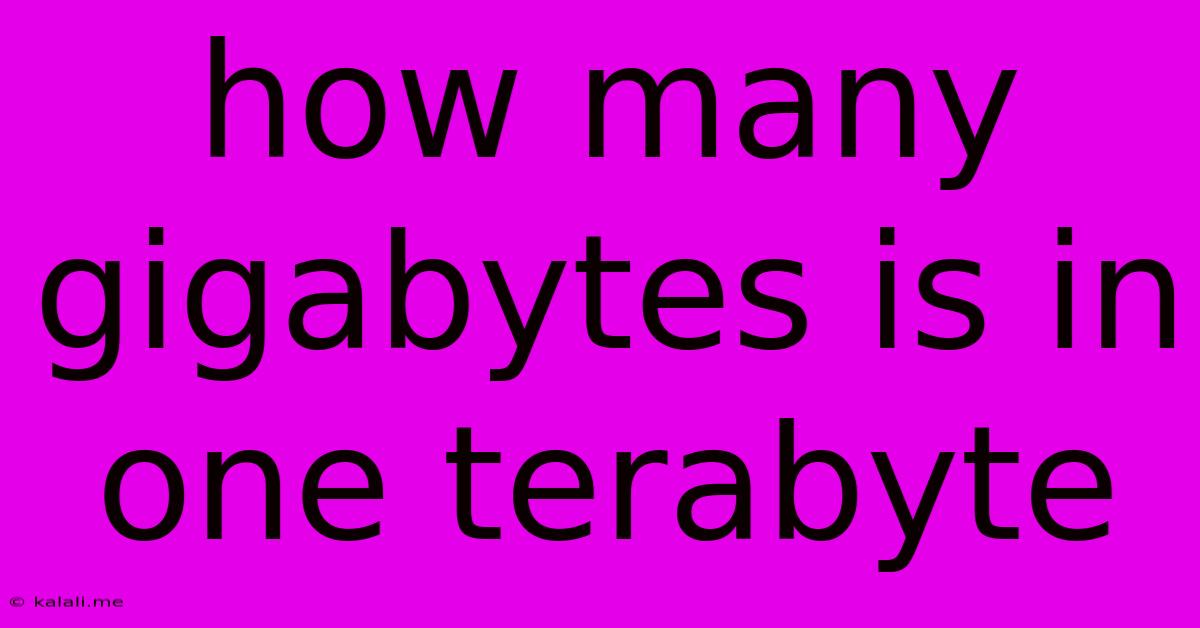How Many Gigabytes Is In One Terabyte
Kalali
Jun 13, 2025 · 3 min read

Table of Contents
How Many Gigabytes are in a Terabyte? A Simple Guide to Data Storage
Understanding data storage units like gigabytes (GB) and terabytes (TB) is crucial in today's digital world. Whether you're buying a new computer, upgrading your cloud storage, or simply trying to understand your phone's memory, knowing the relationship between these units is essential. This article will clearly explain how many gigabytes are in a terabyte and provide some helpful context for understanding data sizes.
What is a Gigabyte (GB)?
A gigabyte is a unit of digital information equal to one billion bytes. Think of it as a relatively small container for your digital files – photos, videos, documents, and apps all take up gigabytes of space. A typical high-definition movie might be around 4 GB, while a simple document might only occupy a few megabytes (MB).
What is a Terabyte (TB)?
A terabyte is significantly larger. It's equal to one trillion bytes, or 1,000 gigabytes. This massive storage capacity is needed for larger collections of digital information. Think of your entire photo library, your music collection, multiple movies, and large software programs – these all require the space provided by terabytes. Many modern computers, especially laptops and desktops, come with terabyte-sized hard drives or solid-state drives (SSDs).
The Conversion: Gigabytes to Terabytes
The simple answer is: There are 1,000 gigabytes (GB) in one terabyte (TB). This is a straightforward conversion; however, it's important to remember that this is a base-10 conversion. In some contexts, you might see slightly different figures due to how computers handle binary data (using base-2), resulting in a slightly smaller number. But for general understanding, 1000 GB per TB is a safe and accurate approximation.
Understanding Data Storage in Context
To get a better feel for these units, let's look at some examples:
- 1 TB: Could hold thousands of photos, hundreds of hours of video, or numerous large software programs. This is a typical hard drive size for a desktop computer.
- 500 GB: A common size for a laptop hard drive or a smaller external drive. It would hold a substantial amount of data, but significantly less than a 1 TB drive.
- 100 GB: This might be the storage capacity of a mid-range smartphone. It's enough for a lot of apps, photos, and music, but it might fill up quickly with high-resolution videos.
Choosing the Right Storage for Your Needs
Understanding the difference between gigabytes and terabytes is critical when choosing storage solutions. Consider your needs:
- Heavy users: If you regularly work with large files (high-resolution videos, large databases, etc.), a terabyte or more is recommended.
- Moderate users: If you primarily use your device for web browsing, email, and basic tasks, 500 GB might be sufficient.
- Light users: A smaller capacity, perhaps in the range of 100-250 GB, might meet your needs if you don't store many large files.
By understanding the relationship between gigabytes and terabytes, you'll be better equipped to make informed decisions about your digital storage needs. Remember the key takeaway: 1 terabyte equals 1,000 gigabytes.
Latest Posts
Latest Posts
-
How Are Protists And Bacteria Different
Jun 14, 2025
-
The General Formula For The Alkane Series Is
Jun 14, 2025
-
A Fishbone Chart Is Also Known As A
Jun 14, 2025
-
First Laboratory Of Psychology Was Established By
Jun 14, 2025
-
Which Action Best Illustrates The Process Of Making An Interpretation
Jun 14, 2025
Related Post
Thank you for visiting our website which covers about How Many Gigabytes Is In One Terabyte . We hope the information provided has been useful to you. Feel free to contact us if you have any questions or need further assistance. See you next time and don't miss to bookmark.